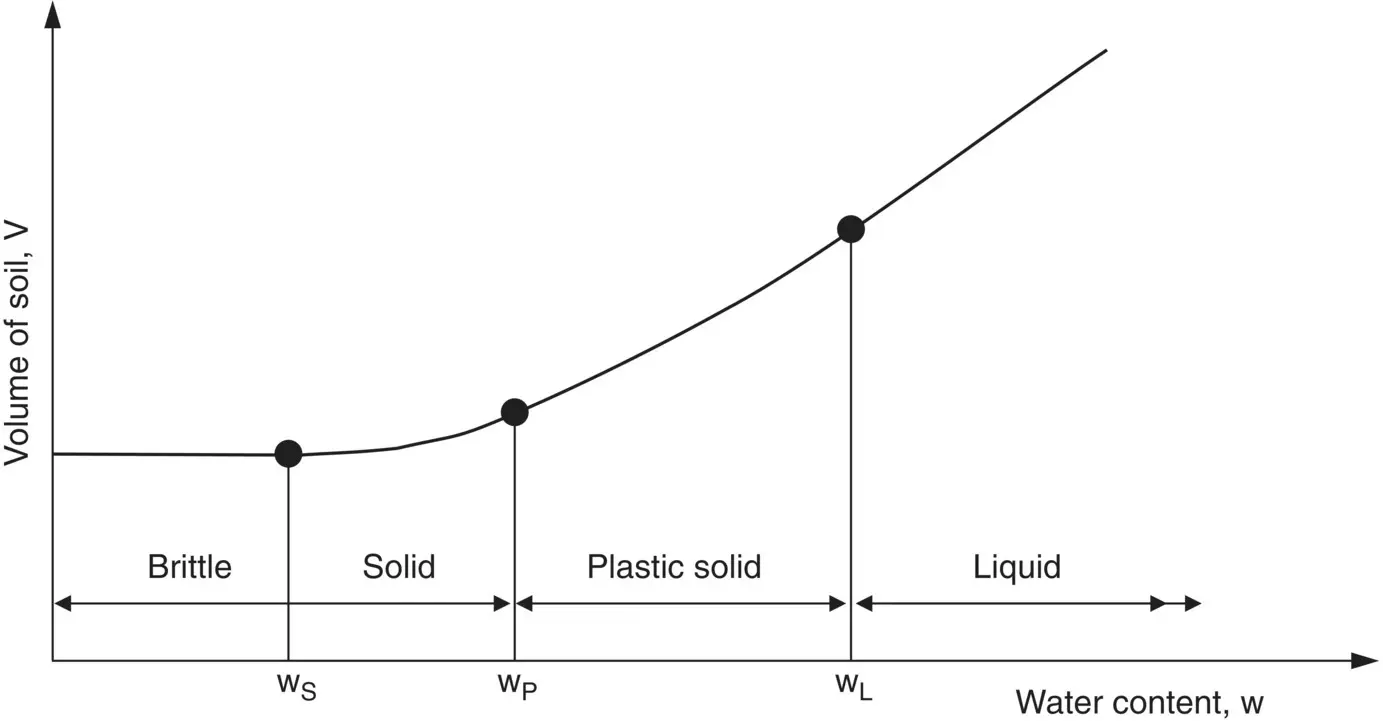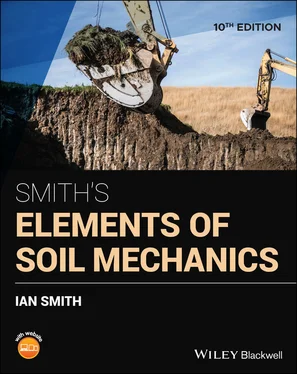The pipette has a standard volume of 10 ml. This equals the volume of the solution sampled. That sample is flushed from the pipette into a small glass weighing bottle. By weighing the bottle before sampling and again after oven drying, the mass of the sampled soil is determined. By scaling the mass retained in the pipette sample (10 ml), less the mass of the dispersant, to that of the cylinder (500 ml), the mass of soil in suspension is determined. That, together with the determination of the particle size at the time of sampling, allows us to establish the percentage of particles passing that size.
The particle size, d (mm), sampled at depth, h (mm), at time, t (min) is established by:
(1.4) 
where
η is the dynamic viscosity of water (mPa s) (=0.89 at 25 °C)
ρs = particle density of the soil (Mg/m3) – see Section 1.7.3.
If samples are taken at 4, 46 and 414 minutes for a soil with particle density of 2.65 Mg/m 3, the particle sizes in each sample will be 0.02, 0.006 and 0.002 mm respectively.
Example 1.3Pipette analysis
The results of a standard pipette analysis, carried out on a sample of soil passing the 63 μm sieve of dry mass 27.25 g and particle density = 2.65 Mg/m 3, were:
|
Sample 1 |
Sample 2 |
Sample 3 |
| Time (min) |
4 |
46 |
414 |
| Mass of empty sample bottle (g) |
5.1926 |
5.3710 |
5.2983 |
| Mass of sample bottle plus dry soil (g) |
5.6927 |
5.8052 |
5.6898 |
During a control test on the dispersant/water only solution (500 ml), it was established that the mass of dry dispersant in a sample of 10 ml was 0.0173 g.
Determine the percentages of fine silt and clay in the soil.
Solution:
Standard test, therefore:Volume of cylinder = 500 ml;Volume of pipette = 10 ml;Water bath temperature = 25 °C;Sampling depth = 100 mm
|
Sample 1 |
Sample 2 |
Sample 3 |
| Particle size, d (mm) |
0.02 |
0.006 |
0.002 |
| Mass of soil in sample (g) |
0.5001 |
0.4342 |
0.3915 |
| Equivalent mass in cylinder (g) |
 |
8.0 |
5.5 |
| Percentage passing d (%) |
 |
76.5 |
68.7 |
From the results it is seen that the percentage of fine silt (0.006–0.002 mm) is 76.5 – 68.7 = 7.8% and the percentage of clay (<0.002 mm) is 68.7%.
1.5.5 Cohesive soils – liquid and plastic limit tests
The results of the grading tests described above can only classify a soil with regard to its particle size distribution. They do not indicate whether the fine grained particles will exhibit the plasticity generally associated with fine grained soils. Hence, although a particle size analysis will completely define a gravel and a sand, it is necessary to carry out plasticity tests in order to fully classify a clay or a fine silt.
These tests were evolved by Atterberg (1911) and determine the various values of water content at which changes in a soil's strength characteristics occur. As an introduction to these tests, let us consider the volume of a soil as the amount of water within it is varied ( Fig. 1.5).
As the water is added to the dry clay, there is no immediate increase in volume. However, as the amount of water is gradually increased, the volume increases too. Also, as the water content changes, the soil behaves differently: when dry, the soil is brittle but when extremely wet, the soil is a liquid (referred to as a slurry ). There is a stage in between the brittle and liquid states and the soil in this range of water contents behaves as a plastic material.
The boundaries to the four states in which a soil may exist are defined:
liquid limit, wL: the boundary between the liquid and the plastic state;
plastic limit, wP: the boundary between the plastic and the semi‐solid state;
shrinkage limit, wS: the boundary between the semi‐solid and the solid state.
The limits are defined as the water contents of the soil at each boundary, as indicated in Fig. 1.5.
Liquid limit (wL) and plastic limit (wP)
The water content at which the soil stops acting as a liquid and starts acting as a plastic solid is known as the liquid limit (w L). If the soil is dried from the liquid limit, it passes through the plastic state. When plastic, the soil can be moulded in the fingers akin to working with modelling clay. But as further water is driven from the soil, the soil no longer behaves as a plastic material and instead acts as a brittle solid. The limit at which plastic behaviour changes to brittle failure is known as the plastic limit (w P).

Fig. 1.5 Changes in volume against water content.
The plasticity index is the range of water content within which a soil is plastic; the finer the soil the greater its plasticity index.

(1.5) 
The liquidity index enables a comparison to be made of a soil's plasticity with its natural water content (w).
(1.6) 
If I L= 1.0 the soil is at its liquid limit. If I L= 0 the soil is at its plastic limit.
If the drying process is prolonged after the plastic limit has been reached, the soil will continue to decrease in volume until a certain value of water content is reached. This value is known as the shrinkage limit and at values of water content below this level the soil is partially saturated. In other words, below the shrinkage limit the volume of the soil remains constant with further drying, but the weight of the soil decreases until the soil is fully dried.
Determination of liquid and plastic limits
The test procedures are given in BS EN ISO 17892‐12 (BSI, 2018).
BS EN ISO 17892‐12 specifies two methods for determining the liquid limit of soil.
1 Fall cone method (preferred method)This is typically referred to as the cone penetrometer test. Details of the apparatus are shown in Fig. 1.6. The soil to be tested is air dried and thoroughly mixed. At least 200 g of the soil is sieved through a 425 μm sieve and placed on a glass plate. The soil is then mixed with distilled water into a paste.A metal cup, approximately 55 mm in diameter and 40 mm deep, is filled with the paste and the surface struck level. The cone, of mass 80 g, is next placed at the centre of the smoothed soil surface and level with it. The cone is released so that it penetrates into the soil and the amount of penetration, over a time period of five seconds, is measured.The test is now repeated by lifting the cone clear, cleaning it and filling up the depression in the surface of the soil by adding a little more of the wet soil.If the difference between the two measured penetrations is less than 0.5 mm then the tests are considered valid, else a third penetration test is done. The average penetration is noted, and a water content determination is carried out on the soil.The procedure is repeated at least four times with increasing water contents. The amount of water used throughout should be such that the penetrations obtained lie within a range of 15–25 mm. Fig. 1.6 Fall cone apparatus.To obtain the liquid limit, the variation of cone penetration is plotted against water content and the best straight line is drawn through the experimental points. The liquid limit is taken to be the water content corresponding to a cone penetration of 20 mm, expressed as a whole number.
Читать дальше



















